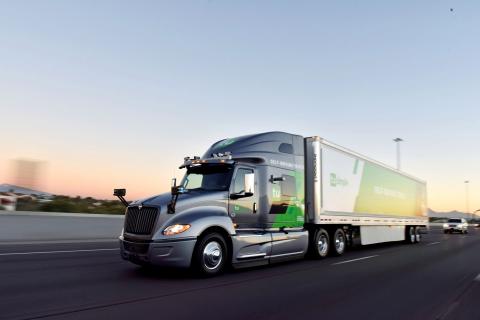The US Postal Service on Tuesday started a two-week test transporting mail across three southwestern states using self-driving trucks, a step forward in the effort to commercialize autonomous vehicle technology for hauling freight.
San Diego-based startup TuSimple said its self-driving trucks will begin hauling mail between USPS facilities in Phoenix and Dallas to see how the nascent technology might improve delivery times and costs. A safety driver will sit behind the wheel to intervene if necessary and an engineer will ride in the passenger seat.
If successful, it would mark an achievement for the autonomous driving industry and a possible solution to the driver shortage and regulatory constraints faced by freight haulers across the country.

Photo: REUTERS
照片:路透
The pilot program involves five round trips, each totaling more than 3,380km or around 45 hours of driving. It is unclear whether self-driving mail delivery will continue after the two-week pilot. “The work with TuSimple is our first initiative in autonomous long-haul transportation,” USPS spokeswoman Kim Frum said. “We are conducting research and testing as part of our efforts to operate a future class of vehicles which will incorporate new technology.”
TuSimple and the USPS declined to disclose the cost of the program, but Frum said no tax dollars were used and the agency relies on revenue from sales of postage and other products. TuSimple has raised US$178 million in private financing, including from chipmaker Nvidia Corp and Chinese online media company Sina Corp.
The trucks will travel on major interstates and pass through Arizona, New Mexico and Texas. “This run is really in the sweet spot of how we believe autonomous trucks will be used,” said TuSimple Chief Product Officer Chuck Price. “These long runs are beyond the range of a single human driver, which means today if they do this run they have to figure out how to cover it with multiple drivers in the vehicle.”
The goal is to eliminate the need for a driver, freeing shippers and freight-haulers from the constraints of a worsening driver shortage. American Trucking Associations estimates a shortage of as many as 174,500 drivers by 2024, due to an aging workforce and the difficulty of attracting younger drivers. A new safety law requiring truck drivers to electronically log their miles has further constrained how quickly and efficiently fleets can move goods.
TuSimple’s tie-up with the USPS marks an achievement for the fledgling self-driving truck industry, and follows Swedish company Einride’s entry into freight delivery using driverless electric trucks on a public road, announced last week.
The developments contrast with retrenching efforts by robotaxi companies such as General Motors Co unit Cruise, Uber Technologies Inc and startup Drive.ai, which have stumbled in building self-driving cars that can anticipate and respond to humans and navigate urban areas, an expensive and technologically challenging feat.
Price said self-driving trucks have advantages over passenger cars, including the relative ease of operating on interstates compared with city centers, which reduces mapping requirements and safety challenges involving pedestrians and bicyclists.
(Reuters)
美國郵政管理局自週二起展開一項為期兩週的測試,使用自動駕駛貨車運送郵件,路程跨越美國西南部的三個州,可說是努力讓自動車科技商業化,用於拖運貨物的重要一步。
總部設於加州聖地牙哥的新創公司TuSimple表示,該公司的自駕貨車將開始行駛於鳳凰城和達拉斯之間,為郵政管理局的據點載運郵件,以測試這項新興科技將可能如何改善運送時間及成本。卡車上將配有一名安全駕駛,坐在方向盤後方,會在必要情況下介入,另一名工程師則會坐在乘客座上。
如果順利的話,這次測試將會是自動駕駛產業的一項里程碑,並且有望解決駕駛員短缺,以及全國貨運業者面對的法規限制。
這項前導計畫包含五次來回,每一次總距離都超過三千三百八十公里,也就是約四十五小時的駕駛時間。目前仍無法確定自駕車郵件投遞在前導計畫結束後是否還會持續。郵政管理局發言人金佛朗姆表示:「和TuSimple的合作是我們第一次主動嘗試採用自動化的長途運輸工具。」她也說:「我們目前正在持續研究和測試,這是我們致力發展未來物流車輛,將新科技納入其中的努力之一。」
TuSimple和郵政管理局拒絕公開計畫成本的金額,但佛朗姆表示這項計畫並沒有用到納稅人的錢,主要仰賴的是郵資以及銷售其它商品帶來的收入。TuSimple則藉由私人募資籌措到一億七千八百萬美元,融資者包括晶片製造商NVIDIA以及中國的網路媒體公司新浪。
自動駕駛貨車將會行駛於主要的州際公路上,穿越亞利桑那州、新墨西哥州,以及德州。TuSimple的產品總監查克‧普萊斯表示:「這段路線真的是我們認為自動卡車可供驅策的甜蜜點。」他指出:「這些長途路程遠遠超過單一一位人類駕駛能掌握的距離,也就是說,如果今天他們要跑這條路線,就得想辦法在車輛內安排多名駕駛來開完全程。」
計畫目標就是解決駕駛員短缺的問題,從而讓託運公司和貨運業者擺脫這項愈趨惡化的問題造成的種種限制。根據美國貨運協會估計,由於行業勞動力老化,又難以吸引年輕駕駛員加入,短缺人數可能在二○二四年達到十七萬四千五百名。新上路的安全法規要求貨車駕駛員必須電子登錄行駛的里程數,又更加限制車隊運送貨物的速度與效率。
TuSimple跟郵政管理局的結盟,對剛在起步階段的自動駕駛貨車產業而言,可說是一項重大成就,也跟上瑞典公司Einride的步伐,後者上週宣布踏入貨物運輸產業,讓無人駕駛的電動貨車行駛於公路上。
這項發展和自動駕駛計程車公司投入資源的日漸緊縮形成對比。包括美國通用汽車旗下的子公司Cruise、優步科技公司,以及新創公司 Drive.ai都在打造自動駕駛車輛的過程中跌跌撞撞,因為他們的自駕車要能夠預期人類行為,並做出反應,還要能在都會區中導航,這項技術不僅昂貴,也相當具有科技上的挑戰性。
普萊斯指出,自駕貨車會比小客車具備更多優勢,包括──跟市中心相比──行駛於州際公路上相對輕鬆,畢竟繪製路線圖的需求降低,面對行人和腳踏車騎士的安全性挑戰也會減少。
(台北時報章厚明譯)

In an effort to fight phone scams, British mobile phone company O2 has introduced Daisy, an AI designed to engage phone con artists in time-wasting conversations. Daisy is portrayed as a kindly British granny, exploiting scammers’ tendency to target the elderly. Her voice, based on a real grandmother’s for authenticity, adds to her credibility in the role. “O2” has distributed several dedicated phone numbers online to direct scammers to Daisy instead of actual customers. When Daisy receives a call, she translates the scammers’ spoken words into text and then responds to them accordingly through a text-to-speech system. Remarkably, Daisy

Bilingual Story is a fictionalized account. 雙語故事部分內容純屬虛構。 Emma had reviewed 41 resumes that morning. While the ATS screened out 288 unqualified, she screened for AI slop. She could spot it a mile away. She muttered AI buzzwords like curses under her breath. “Team player.” “Results-driven.” “Stakeholder alignment.” “Leveraging core competencies.” Each resume reeked of AI modeling: a cemetery of cliches, tombstones of personality. AI wasn’t just changing hiring. It was draining the humanity from it. Then she found it: a plain PDF cover letter. No template. No design flourishes. The first line read: “I once tried to automate my

Every May 1, Hawaii comes alive with Lei Day, a festival celebrating the rich culture and spirit of the islands. Initiated in 1927 by the poet Don Blanding, Lei Day began as a tribute to the Hawaiian custom of making and wearing leis. The idea was quickly adopted and officially recognized as a holiday in 1929, and leis have since become a symbol of local pride and cultural preservation. In Hawaiian culture, leis are more than decorative garlands made from flowers, shells or feathers. For Hawaiians, giving a lei is as natural as saying “aloha.” It shows love and

1. 他走出門,左右看一下,就過了馬路。 ˇ He walked outside, looked left and right, and crossed the road. χ He walked outside and looked left and right, crossed the road. 註︰並列連接詞 and 在這句中連接三個述語。一般的結構是 x, y, and z。x and y and z 是加強語氣的結構,x and y, z 則不可以。 2. 他們知道自己的弱點以及如何趕上其他競爭者。 ˇ They saw where their weak points lay and how they could catch up with the other competitors. χ They saw where their weak points lay and how to catch up with the other competitors. 註:and 一般連接同等成分,結構相等的單詞、片語或子句。誤句中 and 的前面是子句,後面是不定詞片語,不能用 and 連接,必須把不定詞片語改為子句,and 前後的結構才相等。 3. 她坐上計程車,直接到機場。 ˇ She took a cab, which took her straight to the airport. ˇ She took a cab and it took her straight